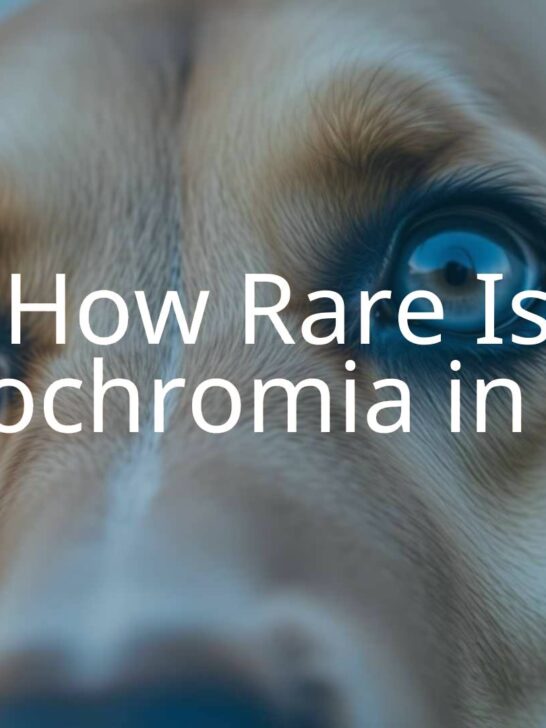German Shepherd With Blue Eyes: How Rare Are They?
The American Kennel Club (AKC) describes the German Shepherd as a popular breed that’s known for its intelligence and loyalty.
It’s a muscular dog that can weigh between 50 and 90 pounds and stand between 22 and 26 inches tall at the shoulders. Males are typically larger than females.
German Shepherds come in different colors. Black-and-tan is the most common and best-known, but German Shepherds can also be black-and-silver or black-and-red.
They can also come in solid colors like black, white, or gray.
Can German Shepherds Have Blue Eyes?
Yes, but it’s not common – the vast majority of German Shepherds have brown eyes.
The few with blue eyes owe their eye color to a recessive gene that needs to be inherited from both parents.
Blue-eyed German Shepherds can have two blue eyes, or they can be odd-eyed with one blue eye and one brown eye.
Dogs with odd eyes are sometimes described as having heterochromia.
While many dog owners consider blue-eyed German Shepherds appealing, breeders consider this to be a fault and so won’t deliberately breed blue-eyed dogs.
Similarly, the AKC disqualifies blue-eyed German Shepherds from dog shows.
What Is A Blue German Shepherd?
A Blue German Shepherd is one with a color variation caused by a recessive gene. It dilutes black pigment so the fur will appear blue-gray or silver-gray rather than black.
Blue German Shepherds can be described as “steel blue” or “powder blue.”
Steel blue GSDs have dark grey fur; in some cases, their fur is so dark that they’re mistaken for black German Shepherds.
On the other hand, powder blue German Shepherds have lighter colors. A blue German Shepherd’s footpads and nose will also be paler than usual.
Blue GSDs can be blue-and-black, blue-and-tan, or blue-and-sable (dark brown).
Their eye colors are similarly diluted – they’ll have light brown, light green, yellow, or blue eyes instead of the usual dark brown.
A German Shepherd’s eyes will normally change to their adult color by the time the pup is around six months old.
Strangely enough, Blue German Shepherds can appear in litters containing prototypical black-and-tan pups.
While the blue color is a normal variation, both the AKC and many breeders consider it a defect of sorts.
As a result, Blue German Shepherds can’t participate in dog shows emphasizing breed standards, but they can take part in agility competitions and similar events.
Can German Shepherd Mixes Have Blue Eyes?
Yes! Well sometimes at least…
The Dog Breed Info website includes a list of dog breeds that are known to have blue eyes on occasion.
While all puppies are born with blue eyes, the breeds listed can actually retain their blue eyes as adults.
A German Shepherd mix can inherit blue eyes from the GSD parent, or from the non-Shepherd parent if the breed has been known to have blue eyes.
For example, PetGuide describes a dog called the Gerberian Shepsky, which is a cross between a German Shepherd and a Siberian Husky.
These dogs, which are also known as Siberian Shepherds or German Huskies, often inherit blue eyes from their Husky parents.
Do German Shepherd With Blue Eyes Have Health Problems?
Generally speaking, blue-eyed German Shepherds are as healthy as their brown-eyed relatives. There are, however, some unfortunate exceptions.
Liam Barnes, a writer for the PlayBarkRun website, describes the merle gene that causes random pigment dilution on the dog’s body.
Dogs with the merle gene will thus have white patches on their body and face, and they’ll often have blue eyes.
While this sounds harmless and even attractive, dogs that inherit the merle gene from both parents often have birth defects.
These dogs, which are called “double merle,” are often born blind, deaf, or both. Mating two carriers of the merle gene is thus considered inhumane and strictly forbidden.
Fortunately, German Shepherds aren’t among the breeds that carry the merle gene. However, a German Shepherd mix can have the merle gene.
Such examples of breeds affected by the merle gene include the Australian Shepherd, the Collie, the Great Dane, and the Shetland Sheepdog.
Are There Albino German Shepherds With Blue Eyes?
Yes. However, Melvin Peña, a writer for “Dogster,” notes that albinism in dogs is rare. The condition is due to a complete lack of pigment in the dog’s skin, fur, and eyes.
An albino dog will thus not only have pure white fur, but the skin around their nose and eyes will be a very pale pink.
The eyes may have some pigment and be a very pale blue, or have no pigment and appear pinkish. The pink color is actually due to the blood flowing beneath the skin.
Albino dogs of any breed are generally healthy, but they are very sensitive to light and are vulnerable to both sunburn and skin cancer.
Are White German Shepherds Albino?
In most cases, no. Shannon Cutts, a writer for “The Happy Pup” explains that different genes are involved.
The genetics behind white German Shepherds aren’t fully understood. The current thinking is that there’s a specific gene determining whether a dog will have a white coat or not.
That gene has two alleles or versions: white and non-white. White is recessive, so a puppy would have to inherit the trait from both parents.
One big difference between white German Shepherds and albinos is that the gene for albinism affects the skin and eyes as well as the coat.
The white/non-white gene only affects coat color.
It doesn’t affect eye color, so most white German Shepherds will have the usual dark brown eyes. Those that do have blue eyes are the result of another recessive gene.
Can A German Shepherd’s Eyes Turn Blue?
Yes – and this usually isn’t a good sign.
There are several conditions that cause a dog’s eyes to appear bluish. Cataracts, for example, cause the lens of the eye to become cloudy and appear to be a hazy blue.
Glaucoma can also make eyes appear cloudy blue. Both of these conditions can cause blindness if they aren’t treated.
Frequently Asked Questions
Are German Shepherds born with blue eyes?
Yes, German Shepherd puppies are born with blue eyes! In fact, all puppies are born with blue eyes, no matter what breed their parents are.
This is because the reason behind puppies having blue eyes has nothing to do with inherited genetics. Instead, it is to do with imbalances in the puppies’ bodies.
Blue eyes are caused by a lack of melanin in the irises. It is natural for puppies to be born with this imbalance, as melanin is something that develops as they age. This is why puppies are born with blue eyes but will grow out of them by the 9-12 week mark.
At this age, the natural color of your puppy’s eyes will replace the blue eyes as the level of melanin in their irises increases.
But, the irises are never really blue. They are actually clear, but they appear to look blue. However, some dog breeds can retain blue eyes as they grow older.
Can Full Blooded German Shepherds have Blue Eyes?
Full-blooded German Shepherds can have blue eyes, however, this is very rare. Blue eyes in German Shepherds are caused by a genetic mutation in the breed line, as the majority of German Shepherds will have brown eyes.
However, this genetic mutation does not mean that your German Shepherd has something wrong with them.
In some dog breeds, blue eyes can be a sign that something is wrong with your pet. But, German Shepherds are one of the few dog breeds where blue eyes are relatively common.
So much so that a sub-breed is recognized for these German Shepherds with blue eyes. They are known as ‘blue Shepherds’.
So yes, full-blooded German Shepherds can have blue eyes, and these dogs are just as healthy as any other kind of German Shepherd.
How much is a German Shepherd with Blue Eyes?
As German Shepherds with blue eyes, or blue Shepherds as they are otherwise known, are relatively rare, you can expect to pay more for them than a regular German Shepherd.
On average, a German Shepherd with brown eyes will cost you between $500-1,500. But a Blue Shepherd will usually cost you a minimum of $1,500.
This is because blue Shepherds are viewed as a premium dog breed. They are very rare, so when a breeder manages to breed this type of German Shepherd successfully, they will want premium prices for the puppies.
Additionally, you should expect to pay higher prices for a German Shepherd that has a single blue eye, as this is also considered premium.
So, you should expect to spend anywhere above $1,500 for a pedigree German Shepherd with blue eyes that will last into adulthood.
Does a Blue eye mean a Dog is blind?
No, a blue eye in your dog does not mean that your dog is blind, or that it is going to go blind at some point. It is common for there to be variation in the pigmentation of a dog’s irises, and this can be caused by lots of different factors. Blindness is rarely the cause of this.
You might also think that blue eyes are a sign that your dog is deaf. This is probably because blue eyes in cats have been linked with deafness. 65-85% of cats that have white fur and blue eyes are deaf, but this correlation does not extend to dogs.
So, no blue eyes are not a sign that your dog is blind. In fact, there are no health concerns linked with blue eyes in dogs, it is simply a genetic mutation.























